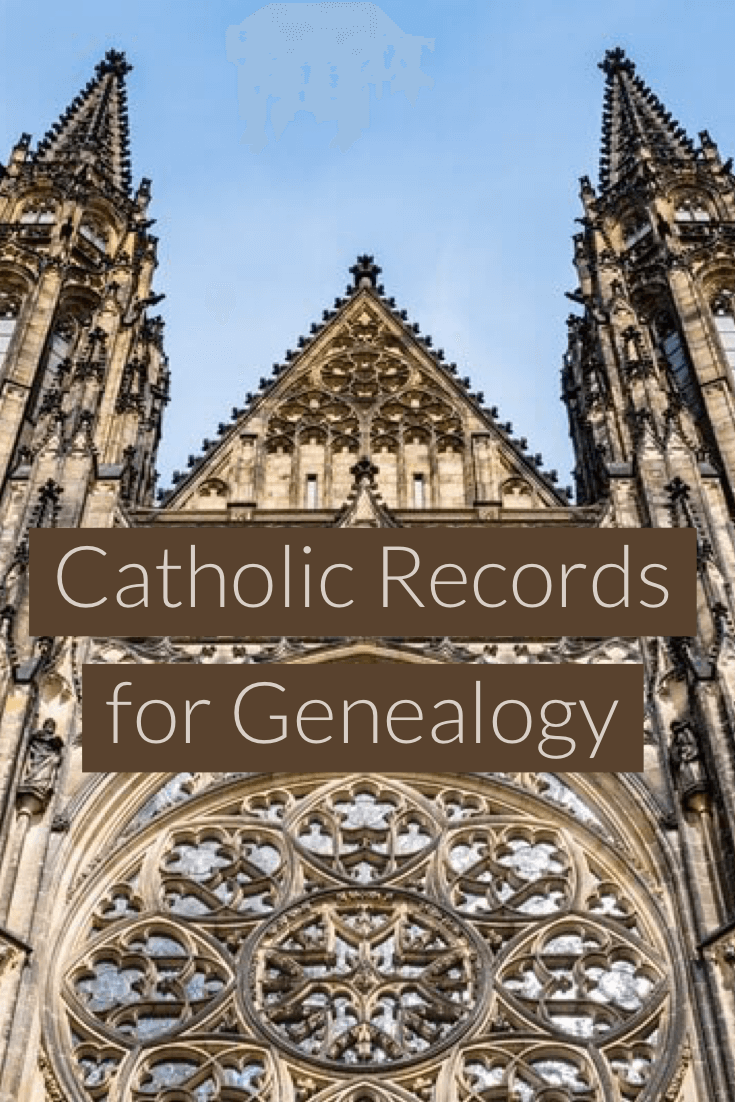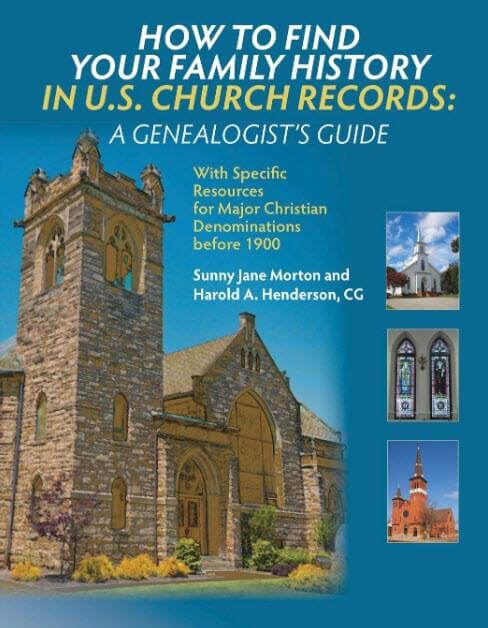by Lisa Cooke | Oct 21, 2017 | 01 What's New, Beginner |
Researching your Polish genealogy may seem a little intimidating at the start. Read these get-started tips from a Polish genealogy veteran at Legacy Tree Genealogists. Then you’ll know how to dive right into your Polish family history–and where to turn if you need a little help.
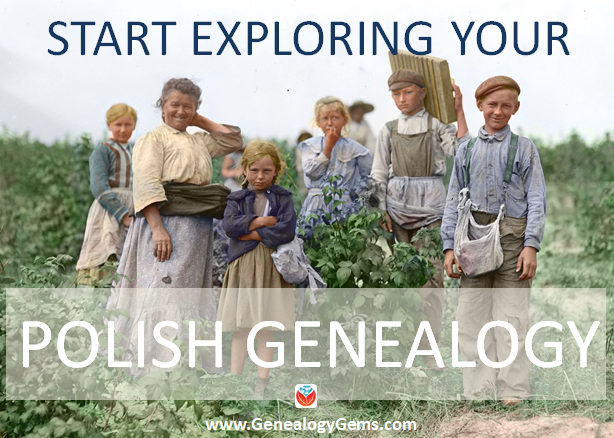
Thanks to Legacy Tree Genealogists for supplying this guest blog post. Legacy Tree employs researchers with a wide range of expertise. They asked their Polish expert, Julie, to share tips for finding Polish ancestors, based on her decades of experience.
If you’re an American researching your Polish ancestors, you aren’t alone. Polish Americans make up the largest Slavic ethnic group in the United States, second largest Central and Eastern European group, and the eighth largest immigrant group overall. So how do you begin tracing your roots in Poland?
Get Started: 4 Polish Genealogy Tips
1. Get to know the basics of Polish history.
Probably every Polish-American family has heard mention of the “border changes” that were supposedly the reason why Grandpa’s papers say he was from Austria, although everyone knew he was Polish. What many people don’t realize is that Poland did not exist as an independent nation from 1795 until 1918. Historically, Polish lands were partitioned among the Russian, Prussian, and Austrian Empires, and ethnic Poles were citizens of one of those three nations. This is why you might see your Polish ancestors stating Russian birth on the 1910 U.S. census, but Polish birth on the 1920 U.S. census, after Poland was reestablished as an independent nation.
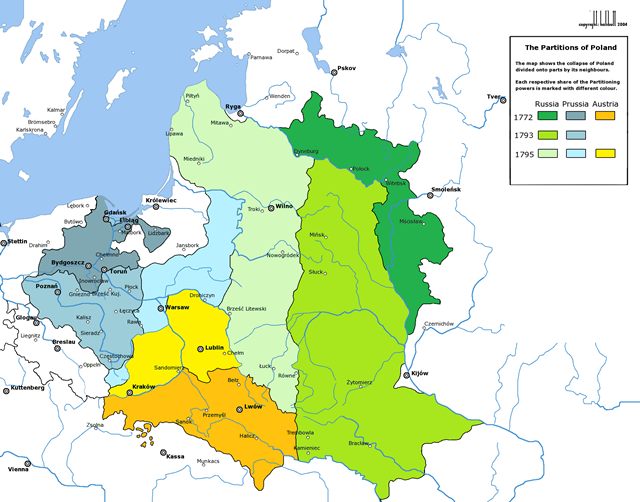
By Rzeczpospolita_Rozbiory_3.png: Halibuttderivative work: Sneecs (talk) – Rzeczpospolita_Rozbiory_3.png, CC BY-SA 3.0, click to view on Wikipedia.
2. Determine your Polish ancestor’s religion.
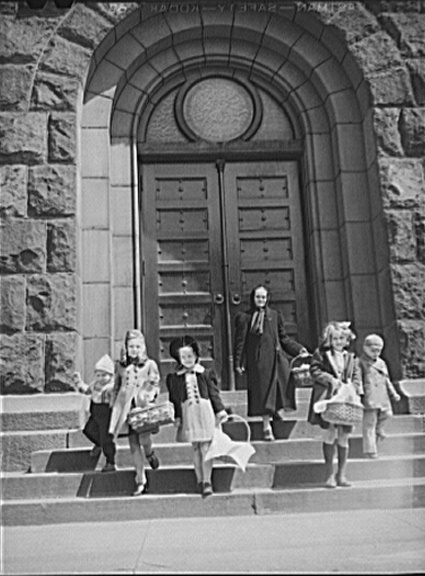
Buffalo, New York. Children of the Polish community leaving church with baskets of food on the day before Easter. Library of Congress photo; digital image via Wikipedia. Click to view.
Although we in the U.S. are accustomed to the separation of church and state, this was not the case in many places. In Poland, it was common for priests, ministers, or rabbis to act as civil registrars, blending ecclesiastical and government authority as they recorded births, marriages, and burials. Although this was the protocol in all three partitions for the majority of the 19th century, the exact span of dates in which this was true vary based on the partition in which your ancestors lived, and greatly affects where you should be searching for the records you need. In “Russian Poland,” for example, civil record keeping began in 1808 with Roman Catholic priests acting as civil registrars for people of all faiths (not just Catholics). Beginning in 1826, each faith was allowed to keep its own civil records using a paragraph-style format that remained relatively stable through the 1930s. Civil registration that was independent of any religious organization did not begin until 1945.
The fact that civil copies of church records were made increases the likelihood that records survived for your ancestor’s town. There’s a persistent myth that “all the records were destroyed in the wars,” but that’s simply not true in most instances. Existing records for some locations date back to the 1600s, but in other places surviving records are sparser.
3. Use U.S. records to determine your ancestor’s precise place of origin.
Grandma may have said that her father came from Warsaw, but most of our ancestors came from small villages, not large cities. It’s more likely that her father was using Warsaw as a point of geographic reference to give people a rough idea of where he lived, since others are unlikely to recognize the name of a small village. This means that you most likely won’t find his birth record by looking for it in Warsaw, but it also leaves you in the dark about where to look instead.
 What kinds of records are most likely to indicate a precise place of birth? Passenger manifests and petitions for naturalization (if dated after 1906) are great sources for this information. If your Polish ancestors were Catholic, church records from the parish they attended in the U.S. are much more likely to contain specific place of birth than their civil equivalents. These include marriage records for immigrants who married in the U.S., baptismal records for U.S.-born children of immigrants, and church death/burial records.
What kinds of records are most likely to indicate a precise place of birth? Passenger manifests and petitions for naturalization (if dated after 1906) are great sources for this information. If your Polish ancestors were Catholic, church records from the parish they attended in the U.S. are much more likely to contain specific place of birth than their civil equivalents. These include marriage records for immigrants who married in the U.S., baptismal records for U.S.-born children of immigrants, and church death/burial records.
Click here for an article about a woman who found her Polish Catholic grandparents’ church marriage record–and with it their overseas birth place–at St. Stanislaus parish in Buffalo, NY. You’ll also learn tips for finding Catholic church records in the U.S.
If your ancestors were Jewish, check cemetery records for mention of any landsmannschaft to which they might have belonged. Landsmannschaften were fraternal aid societies organized by immigrants from the same town in Europe, and they frequently purchased large burial plots for their members.
4. Use a gazetteer to determine the parish or registry office that served your ancestor’s village.
Depending on which partition your ancestors came from, some good gazetteers include:
- The Słownik geograficzny Królestwa Polskiego i innych krajów słowiańskich, or Geographical Dictionary of the Kingdom of Poland and Other Slavic Countries, published between 1880 and 1902 in 15 volumes. The SGKP is written in Polish.
- The Skorowidz Królestwa Polskiego, which includes all of Russian Poland (officially known as the “Królestwo Polskie” or Kingdom of Poland) published in 1877. The SKP is mostly written in Polish with some text in Russian.
- Kartenmeister, an easy-to-use online gazetteer for “German Poland” that covers East Prussia, West Prussia, Brandenburg, Posen, Pomerania, and Silesia. Kartenmeister can be searched using either the German or the Polish name for a town.
- The Galician Town Locator, offered by Gesher Galicia, is another easy-to-use resource that covers the historic Galicia region, which was a part of the Austrian Empire that is now split between Poland and Ukraine.
- The JewishGen Gazetteer is a phonetic gazetteer to assist in identifying the correct location in cases where your ancestor’s place of origin is misspelled on U.S. records. It covers areas throughout Central and Eastern Europe.
Once you have correctly identified both your ancestor’s place of birth and the location of his place of worship or civil records office, you’re ready to make the jump back to records in Poland.
Get Expert Help with Your Polish Genealogy Questions
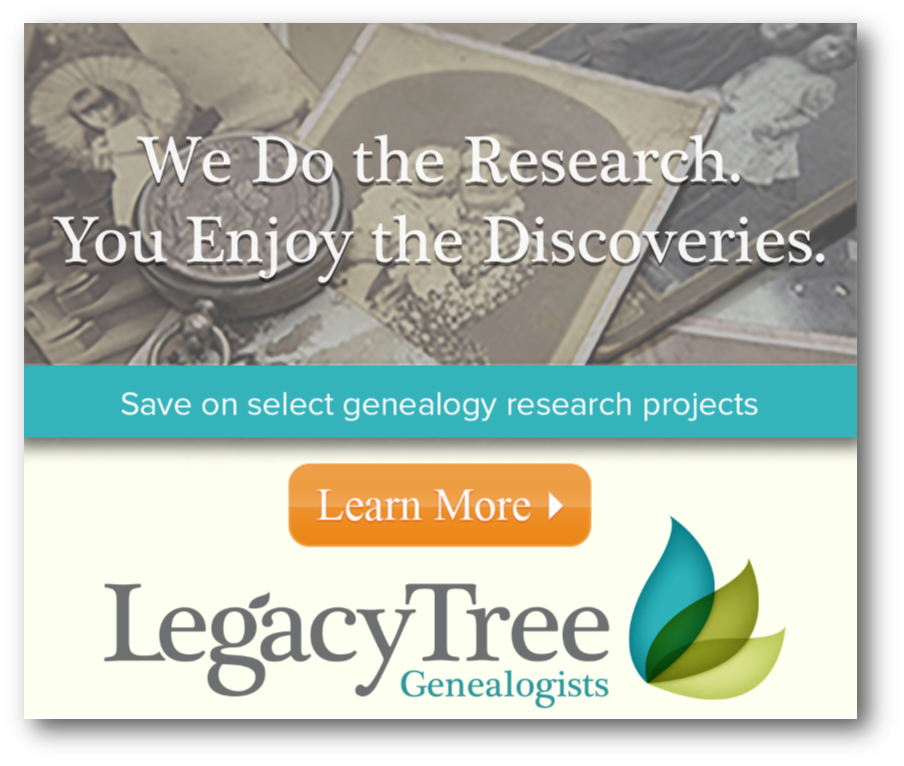 We at Legacy Tree Genealogists would be honored to assist you with any step along the way in your journey to discover your ancestral origins, including onsite research if needed. Our experts have the linguistic and research skills to efficiently find your family. Contact us today for a free consultation.
We at Legacy Tree Genealogists would be honored to assist you with any step along the way in your journey to discover your ancestral origins, including onsite research if needed. Our experts have the linguistic and research skills to efficiently find your family. Contact us today for a free consultation.
Exclusive offer for Genealogy Gems readers: Save $100 on a 20-hour research project using code GG100, valid through October 31st, 2017.
by Sunny | Jul 3, 2018 | 01 What's New, MyHeritage, Newspaper
Through July 8, search free US historical newspapers on MyHeritage.com! Newspapers help you tell compelling family history stories. Collections for several individual states are available–and so is a SuperSearched-version of the nationwide historical newspaper...
by Lisa Cooke | Sep 21, 2015 | 01 What's New, Beginner, History, images, Listeners & Readers, Writing Family History
Do you wish you knew more about your ancestor’s everyday life experience? Use social history for genealogy: to fill in the gaps between documented events.

Recently we heard from Barbara Starmans, a social historian, genealogist and longtime listener of three of Lisa’s podcasts. She wrote to share a new blog she started.
“While I’ve maintained my Out of My Tree Genealogy blog for many years, I’ve just launched The Social Historian, a longform story website featuring social history themed articles from across the centuries and around the world.”
Social history is about “the lives of ordinary people,” explains Barbara. “It is a view of history from the bottom up, rather than from the top down…. [It’s about] understanding…how people lived, worked and played in their daily lives. It is often the minutia of someone’s life that tells the story of who they were and what they believed in.”
“By exploring social history, you will be able to research all the circumstances of your ancestors’ lives and to build their life stories from the details you find.” Barbara send us a great list that we adapted and boiled down to a few core topics:
- Life cycle: Birth and birthing customs, health and lifestyle practices, medicine, diseases and epidemics, mental health, mortality rates, death and burial customs.
- Life at home: Clothing and fashion, food and cooking, housekeeping, land and property, alcohol and drug use.
- Life at work: Economy (prices, cost of living and salaries), occupations, working conditions and the labor movement, businesses and employers, social welfare and relief.
- Relationships: Morality, marriage and divorce, children and childhood, ethnicity and prejudices,
- Community life: Celebrations and holidays, traditions, education, language and literacy, religion/church, faith, crime and punishment, societal unrest, leisure pursuits.
- Game changers: War, emigration, inventions, transportation, communication, slavery and emancipation.
Barbara’s social history blog gives lots of great examples of her belief that “beyond just names and dates, those who came before us have a story to tell….By learning about their time and place and how they lived in it, you can add to your understanding of who they were.”
Resources

The Genealogist’s Google Toolbox by Lisa Louise Cooke is packed with strategies for learning about your ancestors’ lives online. There’s an entire chapter on using Google Scholar for genealogy!
Where can you look for social history online? I’d start with these sites:
1. Make sure you’re using all of Google’s fantastic resources, including Google Books and Google Scholar
2. Click to find Social history resources at the Library of Congress
3. American Social History Project at the City University of New York
Have fun! I think learning about the everyday lives of our ancestors is one of the most fascinating parts of family history.
 Thanks for sharing this post with others who will enjoy it!
Thanks for sharing this post with others who will enjoy it!
by Lacey Cooke | Dec 1, 2017 | 01 What's New, Canadian, Records & databases, United States
New and updated records for Canada and the United States are hot off the press this week. Mortality schedules, cemetery records, Roman Catholic records, and passenger lists are listed for Canadian genealogy research. For the United States, check out Ohio newspapers, New Jersey census records, Confederate maps, and more.

Canada – New and Updated Collections
Ancestry has three brand new collections of Canadian records. First is the Census Mortality Schedule, 1871, covering the provinces of New Brunswick, Nova Scotia, Ontario, and Quebec.
Specifically for Ontario, Toronto Trust Cemeteries, 1826-1989 includes records of several Toronto Cemeteries. And the Roman Catholic Baptisms, Marriages, and Burials, 1760-1923 collection includes indexed records of Ontario baptisms, marriages, and burials. Other records, such as family lists, communions, and confirmations may appear, but do not have associated indices.
At FamilySearch, the collection of Canada Passenger Lists (1881-1922) has been updated with over 33,000 new indexed records. The collection contains an index and images of ships’ passenger lists (also known as ships’ manifests or seaport records of entry).
United States – Newspapers, Census Records, & More
Ohio. MyHeritage has a new collection of Ohio Newspapers from 1793-2009 that you’ll definitely want to explore. These newspapers come from various cities and towns throughout the state and may provide vital records substitutes as well as a glimpse of daily life.
New Jersey. State Census records for New Jersey are now online at Ancestry for the following years: 1855, 1865, 1875, 1885, 1905, and 1915. Records did not survive from all New Jersey counties but all available records are included in this collection.
New York. Brooklyn, Bethlehem Steel Shipyard Employment Cards, 1908-1965 is another new collection at Ancestry. Records include name, age, birth date, next-of-kin, and employment date.
Illinois. New over at FamilySearch are Illinois Mortality Schedules, 1850-1880. This collection lists people who died in the year preceding each census starting in 1850.
National Archives. Over 100 Confederate maps have been digitized at the National Archives. These maps are part of Record Group (RG) 109 and can be viewed online as well as downloaded. Additionally, some of the maps contained unique information on the back, and both sides are available to view in the Catalog.
Railroads. Finally, the Railroad Retirement Pension Index, 1934-1987 is available now at Ancestry. Records vary, but the information found may include birth date, death date, and social security number.
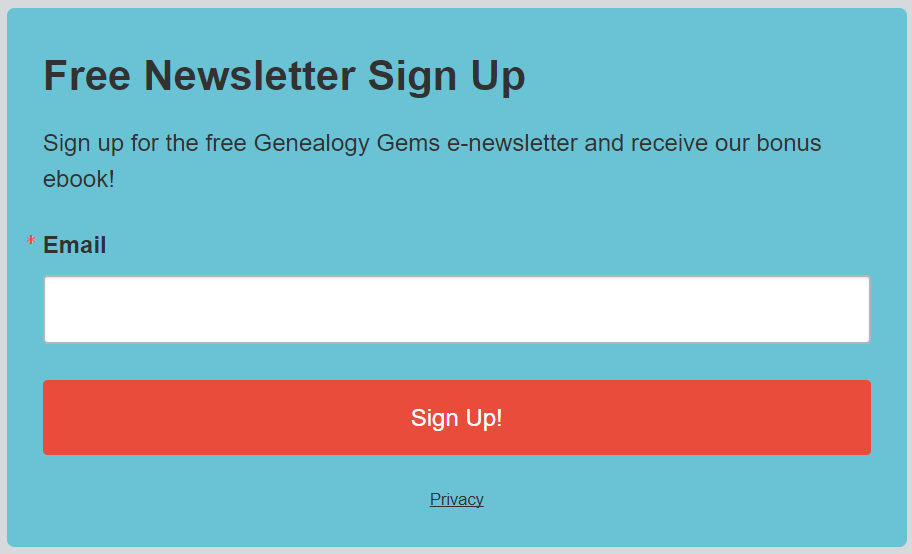 Join the Genealogy Gems newsletter!
Join the Genealogy Gems newsletter!
Our weekly e-newsletter is packed with the latest in all things family history! Included each week is our round-up of new and updated records collections around the web and offline. Get inspiring ideas, brick wall strategies, expert interviews, and more when you sign up for our free newsletter. As a bonus, you’ll get a free ebook of my top Google search strategies! Click here to sign up now.
by Lisa Cooke | Aug 8, 2019 | 01 What's New, Church
A project that began in 2017 to digitize important sacramental records in the history of Boston’s Catholic Church has just been expanded. Here’s the latest on this important project from American Ancestors and the Archdiocese of Boston.
Historic Catholic Records Online Project Expansion
Announced by American Ancestors and the Archdiocese of Boston
20 Additional Years of Records—from 1901 through 1920—and more than 60 Additional Greater Boston Catholic Parishes Are To Be Added to the Historic Digital Genealogy Project at AmericanAncestors.org
August 7, 2019—Boston, Massachusetts—American Ancestors and the Roman Catholic Archdiocese of Boston (RCAB) today announced an expansion of its ongoing program to digitize important sacramental records in the history of Boston’s Catholic Church. This expansion of a project collaboration announced in early 2017 will effectively double the original 11 million names of parishioners to be included when the project is completed to encompass a total of approximately 21 million names—a treasure in research terms for historians, genealogists, scholars, and the public at large. Images are available to browse now. Name-searchable records will be available in an expanded database from American Ancestors on their award-winning website AmericanAncestors.org.
These historic records document several sacraments of the Catholic Church in Boston and surrounding towns including baptism, confirmation, holy communion, marriage, and the anointing of the sick. They are valued for research because they contain detailed information about the Catholic parishioners of greater Boston, their relationships with each other, the church, and often the community.
When announced in January 2017, the Historic Catholic Records Online Project—the first of its type in the U.S. to digitize a significant number of sacramental records from any U.S.-based Catholic archdiocese—encompassed 154 parishes in 84 towns within the Boston Archdiocese, covering the years 1789 to 1900.
Today’s announcement extends the project’s reach to cover records through the year 1920—adding 20 additional years of sacramental records to the project and eventually bringing more than 60 new parishes within it—all formed within the Boston Archdiocese after 1900.
Catholic parishes in the towns of
- Billerica,
- Danvers,
- Dracut,
- Forest Hills,
- Groton,
- Mattapan,
- Methuen,
- North Andover,
- Saugus,
- Sharon,
- Shirley,
- Swampscott,
- Wakefield,
- Wilmington,
- and Winthrop
will now be included—covering important phases of greater Boston’s early 20th-century history and stories of immigration, social, and cultural change.
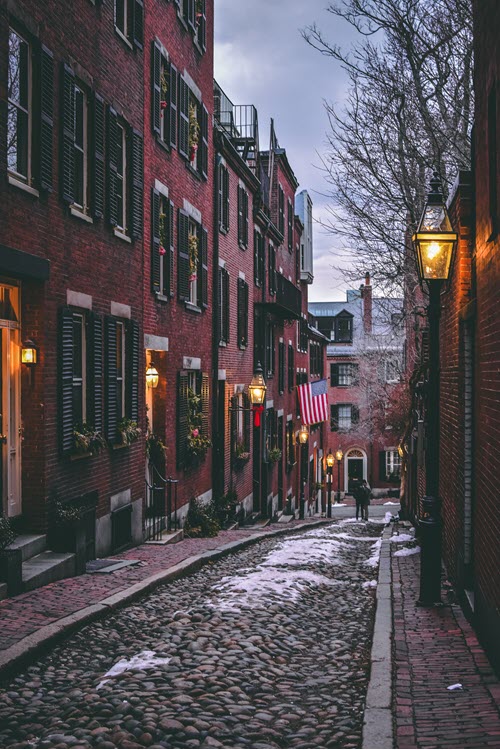
Boston
Brenton Simons, President and CEO of American Ancestors, also known as New England Historic Genealogical Society, celebrated the amplification of the project, noting “Throughout our 175-year history, New England Historic Genealogical Society has collected and shared countless manuscripts, artifacts, data, and other resources that tell the inspiring story of the American family. The expansion of this historic collaboration between the Boston Archdiocese and American Ancestors will enrich the research of family historians in America and beyond and be especially informative in Irish, Italian, and French Canadian genealogy. Newer parishes from the 1900s add Lithuanian, Polish, and Portuguese genealogical data of interest.
“I offer our deep gratitude to the Roman Catholic Archdiocese of Boston for recognizing the historical value of this data—especially Thomas Lester, the Archivist and Records Manager of the Archdiocese, whose forward-thinking vision toward preservation and collaboration inspired this important project and its expansion we are announcing today,” Simons said.
Lester, as the Boston Archdiocese’s leading advocate for records preservation, stated “We recognize the value of this collection to many groups, foremost among them historians and genealogists. This second, expanded phase of our project with American Ancestors, is a result of the overwhelming positive feedback received during the initial phase announced with them in January 2017.
“Use of the records by researchers around the world has exceeded our original expectations and we are excited to offer additional content, with more insights, and deeper glimpses into the history of the Roman Catholic people and parishes in greater Boston. Of equal importance is that we are continuing to create a digital backup to help preserve these irreplaceable records.”
“The completion of the expanded project, covering all records through the year 1920 is now anticipated to be by the year 2029,” stated Molly Rogers, Database Coordinator for American Ancestors, “with all browsable (non-indexed) and indexed names from all parish archives expected to be online by that time.”
The project is enormous in scope, with a large amount of data to be digitized and then laboriously, manually indexed, transcribed, and, in most cases, translated to English for name-searching capabilities.
Some of the first records from this expanded time period—browsable images of pages from parish archives—are available and may be viewed at AmericanAncestors.org/image-example by members of American Ancestors and by non-members alike, with a free online registration as a Guest Member at AmericanAncestors.org/membership/guest-users. Searchable records (indexed by name) are available only to subscribing members of American Ancestors—visit AmericanAncestors.org/Join.
Volunteers coordinated by the staff of American Ancestors undertake the greater portion of the work of scanning and indexing the Historic Catholic Records Online Project documents.
Much of this effort is carried out at the American Ancestors headquarters in Boston’s Back Bay. In 2017, American Ancestors launched a Historic Catholic Records Fund to enable philanthropy to support the project. Information about contributing to this fund can be found at AmericanAncestors.org/catholic-records-fund.
# # #
About American Ancestors and New England Historic Genealogical Society
American Ancestors, also known as New England Historic Genealogical Society (NEHGS), with its national headquarters located in Boston’s Back Bay, is the oldest and largest genealogical organization in America. It serves more than 260,000 members and millions of online users engaged in family history nationally and around the world. It is home to a world-class research library and archive, and an expert staff.
American Ancestors offers an award-winning genealogical research website at AmericanAncestors.org with more than 1.4 billion records and maintains a publishing division which produces original genealogical research, scholarship, and educational materials, including Mayflower Descendant, a quarterly journal of Pilgrim genealogy and history.
Resources for Using Church Records for Genealogy
Disclosure: This article contains affiliate links and Genealogy Gems will be compensated if you make a purchase after clicking on these links (at no additional cost to you). Thank you for supporting Genealogy Gems!



 What kinds of records are most likely to indicate a precise place of birth? Passenger manifests and petitions for naturalization (if dated after 1906) are great sources for this information. If your Polish ancestors were Catholic, church records from the parish they attended in the U.S. are much more likely to contain specific place of birth than their civil equivalents. These include marriage records for immigrants who married in the U.S., baptismal records for U.S.-born children of immigrants, and church death/burial records.
What kinds of records are most likely to indicate a precise place of birth? Passenger manifests and petitions for naturalization (if dated after 1906) are great sources for this information. If your Polish ancestors were Catholic, church records from the parish they attended in the U.S. are much more likely to contain specific place of birth than their civil equivalents. These include marriage records for immigrants who married in the U.S., baptismal records for U.S.-born children of immigrants, and church death/burial records. We at Legacy Tree Genealogists would be honored to assist you with any step along the way in your journey to discover your ancestral origins, including onsite research if needed. Our experts have the linguistic and research skills to efficiently find your family. Contact us today for a free consultation.
We at Legacy Tree Genealogists would be honored to assist you with any step along the way in your journey to discover your ancestral origins, including onsite research if needed. Our experts have the linguistic and research skills to efficiently find your family. Contact us today for a free consultation.




